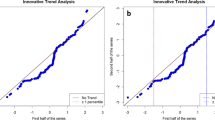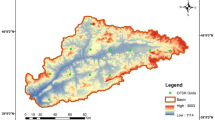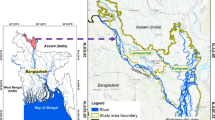Abstract
In developing countries, hydrological modeling in support of decision-making and planning of hydrological resources is often hindered by the scarcity of in situ hydro-meteorological data and uneven distribution of observation stations. Satellite-based precipitation products (SPPs) can potentially play a role in overcoming the challenge posed by insufficient and inconsistent in situ precipitation measurements. However, their performance in estimating observations needs to be evaluated before their application in hydrological modeling. This paper evaluates and compares four high-resolution SPPs [ARC2 (African Rainfall Climatology version 2), CHIRPS (Climate Hazard Group Infrared Precipitation with Station data), TMPA 3B42v7 (Tropical Rainfall Measuring Mission Multi-satellite Precipitation Analysis 3B42 product), and PERSIANN-CDR (Precipitation Estimation from Remotely Sensed Information using Artificial Neural Networks)] with measurements from rain-gauge stations (2007–2016) over the Upper Tana River Basin (UTRB). Performance of the SPPs is evaluated using continuous [correlation coefficient (R), mean absolute error (MAE), root mean square error (RMSE), Nash–Sutcliffe efficiency coefficient (NSE), and percent bias (PBIAS)] and categorical [POD (probability of detection), FAR (false alarm ratio), CSI (critical success index), and ETS (equitable threat score)] metrics at daily, dekadal, and monthly time steps. The daily, dekadal, and monthly R of ARC2 SPP were 0.8, 0.92, and 0.94, respectively. The R of CHIRPS (TMPA 3B42v7) is 0.53 (0.63), 0.82 (0.83), and 0.93 (0.95). The daily RMAEs for ARC2, CHIRPS, TMPA 3B42v7, and PERSIANN-CDR are 0.73, 1.27, 1.17, and 1.04, while the RRMSEs are 2.94, 4.52, 4.03, and 3.85, respectively. PBIAS indicates that all the SPPs except CHIRPS underestimated precipitation. It is shown that ARC2 and CHIRPS are better in reproducing the occurrence frequency of daily events for the different intensity ranges. Also, ARC2 was the best performing SPP with regard to the ability to detect precipitation events. It is observed that all SPPs were able to detect low-intensity precipitation events but poor in detecting intensity events higher than 25 mm/day. Overall, ARC2 provided the most accurate precipitation estimates, although CHIRPS and TMPA 3B42v7 also showed good performance in reproducing and detecting precipitation.









Similar content being viewed by others
References
Alazzy AA, Lü H, Chen R, Ali AB, Zhu Y, Su J (2017) Evaluation of satellite precipitation products and their potential influence on hydrological modeling over the Ganzi river basin of the Tibetan plateau. Adv Meteorol 2017:1–23
Asadullah A, McIntyre N, Kigobe M (2008) Evaluation of five satellite products for estimation of rainfall over Uganda. Hydrol Sci J 53(6):1137–1150. https://doi.org/10.1623/hysj.53.6.1137
Ashouri H, Hsu KL, Sorooshian S, Braithwaite DK, Knapp KR, Cecil LD, Nelson BR, Prat OP (2015) PERSIANN-CDR: Daily precipitation climate data record from multisatellite observations for hydrological and climate studies. Bull Am Meteorol Soc 96(1):69–83. https://doi.org/10.1175/BAMS-D-13-00068.1
Baker T, Kiptala J, Olaka L, Oates N (2015) Baseline review and ecosystem services assessment of the Tana River Basin, Kenya: IWMI Working Paper 165
Behrangi A, Hsu K, Imam B, Sorooshian S (2010) Daytime Precipitation Estimation Using Bispectral Cloud Classification System. J Appl Meteorol Climatol 49:1015–1031. https://doi.org/10.1175/2009JAMC2291.1
Behrangi A, Khakbaz B, Jaw TC, AghaKouchak A, Hsu K, Sorooshian S (2011) Hydrologic evaluation of satellite precipitation products over a mid-size basin. J Hydrol 397(3–4):225–237. https://doi.org/10.1016/j.jhydrol.2010.11.043
Bitew MM, Gebremichael M (2011) Assessment of satellite rainfall products for streamflow simulation in medium watersheds of the Ethiopian highlands. Hydrol Earth Syst Sci 15(4):1147–1155. https://doi.org/10.5194/hess-15-1147-2011
Dembélé M, Zwart SJ (2016) Evaluation and comparison of satellite-based rainfall products in Burkina Faso, West Africa. Int J Remote Sens 37(17):3995–4014. https://doi.org/10.1080/01431161.2016.1207258
Diem JE, Hartter J, Ryan SJ, Palace MW (2014) Validation of Satellite Rainfall Products for Western Uganda. J Hydrometeorol 15(5):2030–2038. https://doi.org/10.1175/JHM-D-13-0193.1
Dinku T, Ceccato P, Grover-Kopec E, Lemma M, Connor SJ, Ropelewski CF (2007) Validation of satellite rainfall products over East Africa’s complex topography. Int J Remote Sens 28(7):1503–1526. https://doi.org/10.1080/01431160600954688
Dinku T, Ceccato P, Connor SJ (2011) Challenges of satellite rainfall estimation over mountainous and arid parts of east africa. Int J Remote Sens 32(21):5965–5979. https://doi.org/10.1080/01431161.2010.499381
Duan Z, Liu J, Tuo Y, Chiogna G, Disse M (2016) Evaluation of eight high spatial resolution gridded precipitation products in Adige Basin (Italy) at multiple temporal and spatial scales. Sci Total Environ 573:1536–1553. https://doi.org/10.1016/j.scitotenv.2016.08.213
Fenta AA, Yasuda H, Shimizu K, Ibaraki Y, Haregeweyn N, Kawai T, Belay AS, Sultan D, Ebabu K (2018) Evaluation of satellite rainfall estimates over the Lake Tana basin at the source region of the Blue Nile River. Atmos Res 212:43–53. https://doi.org/10.1016/j.atmosres.2018.05.009
Funk C, Peterson P, Landsfeld M, Pedreros D, Verdin J, Shukla S, Husak G, Rowland J, Harrison L, Hoell A, Michaelsen J (2015) The climate hazards infrared precipitation with stations—a new environmental record for monitoring extremes. Sci Data 2(1):1–21. https://doi.org/10.1038/sdata.2015.66
Gichuki P, Vigerstol K (2014) Presentation from the 2014 World Water Week in Stockholm
Githungo W, Otengi S, Wakhungu J, Masibayi E (2016) Infilling monthly rain gauge data gaps with satellite estimates for ASAL of Kenya. Hydrology 3(4):40. https://doi.org/10.3390/hydrology3040040
Hsu KL, Gao X, Sorooshian S, Gupta HV (1997) Precipitation estimation from remotely sensed information using artificial neural networks. J Appl Meteorol 36:1176–1190. https://doi.org/10.1175/1520-0450(1997)036%3c1176:PEFRSI%3e2.0.CO;2
Huffman GJ, Bolvin DT, Nelkin EJ, Wolff DB, Adler RF, Gu G, Hong Y, Bowman KP, Stocker EF (2007) The TRMM multisatellite precipitation analysis (TMPA): quasi-global, multiyear, combined-sensor precipitation estimates at fine scales. J Hydrometeorol 8(1):38–55. https://doi.org/10.1175/JHM560.1
Jacobs JH, Angerer J, Vitale J, Srinivasan R, Kaitho R (2007) Mitigating economic damage in Kenya’s Upper Tana River Basin: an application of arc-view SWAT. J Spat Hydrol 7(1):23–46
Khan SI, Hong Y, Gourley JJ, Khattak MUK, Yong B, Vergara HJ (2014) Evaluation of three high-resolution satellite precipitation estimates: potential for monsoon monitoring over Pakistan. Adv Space Res 54(4):670–684. https://doi.org/10.1016/j.asr.2014.04.017
Kimani MW, Hoedjes JCB, Su Z (2017) An assessment of satellite-derived rainfall products relative to ground observations over East Africa. Remote Sens 9(5):430. https://doi.org/10.3390/rs9050430
Koo MS, Hong SY, Kim J (2009) An evaluation of the tropical rainfall measuring mission (TRMM) multi-satellite precipitation analysis (TMPA) data over South Korea. Asia-Pac J Atmos Sci 45(3):265–282
Lekula M, Lubczynski MW, Shemang EM, Verhoef W (2018) Validation of satellite-based rainfall in Kalahari. Phys Chem Earth 105:84–97. https://doi.org/10.1016/j.pce.2018.02.010
Li Z, Yang D, Hong Y (2013) Multi-scale evaluation of high-resolution multi-sensor blended global precipitation products over the Yangtze River. J Hydrol 500:157–169. https://doi.org/10.1016/j.jhydrol.2013.07.023
Li X, Zhang Q, Xu CY (2014) Assessing the performance of satellite-based precipitation products and its dependence on topography over Poyang Lake basin. Theoret Appl Climatol 115(3–4):713–729. https://doi.org/10.1007/s00704-013-0917-x
Mashingia F, Mtalo F, Bruen M (2014) Validation of remotely sensed rainfall over major climatic regions in Northeast Tanzania. Phys Chem Earth 67–69:55–63. https://doi.org/10.1016/j.pce.2013.09.013
Nijssen B, Lettenmaier DP (2004) Effect of precipitation sampling error on simulated hydrological fluxes and states: anticipating the global precipitation measurement satellites. J Geophys Res 109(D2):D02103. https://doi.org/10.1029/2003JD003497
Novella NS, Thiaw WM (2013) African rainfall climatology version 2 for famine early warning systems. J Appl Meteorol Climatol 52(3):588–606. https://doi.org/10.1175/JAMC-D-11-0238.1
Oludhe C, Sankarasubramanian A, Sinha T, Devineni N, Lall U (2013) The role of multimodel climate forecasts in improving water and energy management over the tana river basin, Kenya. J Appl Meteorol Climatol 52(11):2460–2475. https://doi.org/10.1175/JAMC-D-12-0300.1
Omondi P, Ogallo LA, Anyah R, Muthama JM, Ininda J (2013) Linkages between global sea surface temperatures and dekadal rainfall variability over Eastern Africa region. Int J Climatol 33(8):2082–2104. https://doi.org/10.1002/joc.3578
Pal R (2017) Validation methodologies 4. In: Pal Ranadip (ed) Predictive modeling of drug sensitivity. Academic Press, Cambridge, pp 83–107
Rahman KU, Shang S, Shahid M, Wen Y (2020) Hydrological evaluation of merged satellite precipitation datasets for streamflow simulation using SWAT: a case study of Potohar Plateau, Pakistan. J Hydrol 587:125040. https://doi.org/10.1016/j.jhydrol.2020.125040
Ren P, Li J, Feng P, Guo Y, Ma Q (2018) Evaluation of multiple satellite precipitation products and their use in hydrological modelling over the Luanhe River Basin, China. Water (Switzerland) 10(6):677. https://doi.org/10.3390/w10060677
Sorooshian S, Hsu KL, Gao X, Gupta HV, Imam B, Braithwaite D (2000) Evaluation of PERSIANN system satellite-based estimates of tropical rainfall. Bull Am Meteor Soc 81(9):2035–2046. https://doi.org/10.1175/1520-0477(2000)081%3c2035:EOPSSE%3e2.3.CO;2
Sorooshian S, AghaKouchak A, Arkin P, Eylander J, Foufoula-Georgiou E, Harmon R, Hendrickx JM, Imam B, Kuligowski R, Skahill B, Skofronick-Jackson G (2011) Advanced concepts on remote sensing of precipitation at multiple scales. Bull Am Meteorol Soc 92(10):1353–1357. https://doi.org/10.1175/2011BAMS3158.1
Tan ML, Ibrahim AL, Duan Z, Cracknell AP, Chaplot V (2015) Evaluation of six high-resolution satellite and ground-based precipitation products over Malaysia. Remote Sens 7(2):1504–1528. https://doi.org/10.3390/rs70201504
Thiemig V, Rojas R, Zambrano-Bigiarini M, De Roo A (2013) Hydrological evaluation of satellite-based rainfall estimates over the Volta and Baro-Akobo Basin. J Hydrol 499:324–338. https://doi.org/10.1016/j.jhydrol.2013.07.012
Toté C, Patricio D, Boogaard H, van der Wijngaart R, Tarnavsky E, Funk C (2015) Evaluation of satellite rainfall estimates for drought and flood monitoring in Mozambique. Remote Sens 7(2):1758–1776. https://doi.org/10.3390/rs70201758
Wambua RM, Mutua BM, Raude JM (2015) Spatio-temporal drought characterization for the upper Tana River Basin, Kenya using standardized precipitation index (SPI). World J Environ Eng 3(4):111–120. https://doi.org/10.12691/wjee-3-4-2
Ward E, Buytaert W, Peaver L, Wheater H (2011) Evaluation of precipitation products over complex mountainous terrain : a water resources perspective. Adv Water Resour 34:1222–1231. https://doi.org/10.1016/j.advwatres.2011.05.007
Willmott CJ (1982) Some comments on the evaluation of model performance. Bull Am Meteor Soc 63(11):1309–1313
Worqlul AW, Maathuis B, Adem AA, Demissie SS, Langan S, Steenhuis TS (2014) Comparison of rainfall estimations by TRMM 3B42, MPEG and CFSR with ground-observed data for the Lake Tana basin in Ethiopia. Hydrol Earth Syst Sci 18(12):4871–4881. https://doi.org/10.5194/hess-18-4871-2014
Zambrano-bigiarini M, Nauditt A, Birkel C, Verbist K, Ribbe L (2017) Temporal and spatial evaluation of satellite-based rainfall estimates across the complex topographical and climatic gradients of Chile. Hydrol Earth Syst Sci 21:1295–1320. https://doi.org/10.5194/hess-21-1295-2017
Acknowledgements
We would like to appreciate all the sources of data used in this study namely, NOAA NCEP CPC for ARC2, the Climate Hazards Group for CHIRPS, Goddard Earth Sciences Data and Information Services Center for TRMM, and NOAA NCDC for PERSIANN-CDR.
Funding
There is no funding source to declare.
Author information
Authors and Affiliations
Contributions
FP was involved in the supervision, resources, investigation, and writing—review and editing. QBP contributed to the supervision and writing—review and editing. DTA contributed to the conceptualization, methodology, investigation, writing—original draft, and writing—review and editing. KUR contributed to the visualization and investigation. MS and RSA contributed to the writing—original draft, writing—review and editing, and software.
Corresponding author
Ethics declarations
Conflict of interest
The authors declare no conflict of interest.
Additional information
Editorial responsibility: Samareh Mirkia.
Rights and permissions
About this article
Cite this article
Polong, F., Pham, Q.B., Anh, D.T. et al. Evaluation and comparison of four satellite-based precipitation products over the upper Tana River Basin. Int. J. Environ. Sci. Technol. 20, 843–858 (2023). https://doi.org/10.1007/s13762-022-03942-1
Received:
Revised:
Accepted:
Published:
Issue Date:
DOI: https://doi.org/10.1007/s13762-022-03942-1




